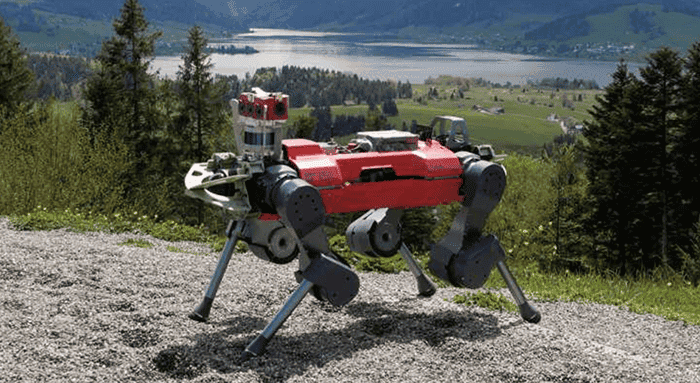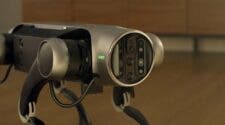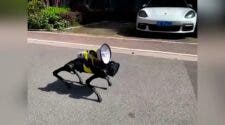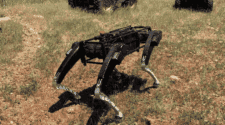Researchers have launched a dog-like quadruped robot (robot dogs) that combines external and proprioceptive perception to climb a 120-meter-high mountain in just 31 minutes. This is four minutes faster than the time it takes for humans to walk on foot. Mountains are often composed of steep sections on slippery ground and it has high steps, gravel, and forest trails full of tree roots. Legged robots that can operate autonomously in remote and dangerous environments will help humans explore higher altitudes and virgin territories.
External perception is critical for fast and energy-efficient locomotion, and robots sensing the terrain before it touches the terrain can plan and adapt in advance to maintain speed and stability. A research group led by Marco Hutter, professor of robotics at the Robotics Systems Laboratory at ETH Zurich, Switzerland, and ANYbotics, a spin-off company of the school, have launched a commercialized legged quadruped robot, ANYmal, which can travel through multiple types of complex terrain.
The company and developers outlined the top 3 locomotion development of robot dogs to make them “perfect”.

1. Do not rely on sensors, independently judge the speed
To navigate difficult terrain, humans, and animals automatically combine the visual perception of their environment with the proprioception of their legs and hands. This allows them to deal with slippery or loose ground with ease and to move around more easily. So far, though, legged robots have only been able to do this to a limited extent.
“The reason is that the information about the immediate environment recorded by laser sensors and cameras is often incomplete and ambiguous,” explains Takahiro Miki, a doctoral student in Hurt’s research group and lead author of the study.
The ability of robots to act using external perception is a major challenge in this technology. First, the snow, vegetation and water surfaces on the mountain have high reflectivity, and the robot will see them as obstacles that cannot be stepped on or disappear completely. Secondly, the visibility is low due to dust, fog on the mountain, or light reflection and vegetation blocking the sensors on the robot. These may cause the sensor’s perception to decrease.
Affected by these factors, the most common solution for robot leg movement is proprioception. This also severely limits its movement speed, because the robot needs to feel the terrain first and then adjusts.
“That’s why a robot like ANYmal must be able to decide for itself when to trust its visual perception of the environment and move fast, and when it’s best to proceed cautiously and take small steps,” says Takahiro Miki.

2. The controller quickly avoids obstacles
The more general solution proposed by the research team led by Hurt integrates the extrinsic and proprioceptive sensations of the robot’s leg movements. The researchers developed a legged motion controller with high robustness and speed using an attention-based recurrent encoder. The encoder can integrate proprioceptive and extrinsic inputs and is trained end-to-end. This allows the robot to learn to seamlessly and combine different perception modalities.
Gizchina News of the week
“Robots have learned to combine visual perception of their environment with proprioception, or touch-based on direct leg contact. This allows it to navigate rough terrain faster, more efficiently and, most importantly, more robust. In the future, ANYmal could be used anywhere that is too dangerous for humans, or difficult for other robots to get through”, Hurt said.
Before the robot can actually act in the real world, scientists set up numerous obstacles for the quadruped robot in a virtual training camp. This will ensure that it can find the ideal way to overcome many obstacles.
“It’s important to evaluate the robot’s external perception in experiments,” Hurt said. The researchers also compared the success rate of the robot’s actions in various stair and stair terrains in additional experiments in the simulation to further quantitatively assess its performance.

Robot dogs testing and evaluation
During the evaluation, the researchers commanded the robot a fixed forward speed of 0.7m/s for 10 seconds. The testing also involves collecting 300 experimental data to calculate the success rate. The criterion for the success of the experiment is whether the robot’s action distance exceeds 4 meters. The results of the study show that the controller performance of this quadruped robot is significantly better than the baseline. It can traverse more types of terrain ranges.
3. Training iterative in multiple environments
The research team also employed a teacher-student model to train the robot dogs. During training, Hurt set the control frequency of the information policy to 50 Hz. He also collected trajectory data for 250 time periods per environment to form a training iteration. They then parallelized the simulated environments to perform training on 1000 environments simultaneously.
For the teacher model, the researchers used the deep reinforcement learning PPO algorithm. This can effectively measure the step size of the robot. Before pooling observations together, they normalize them using a running mean and standard deviation. Also, different experiments are updated exponentially with each training session.
For the student model, Hurt said, “We generalized on 300 environments and collected trajectories for 400 time periods for one training iteration…Through this training, the robot is able to master the most difficult natural terrain in situations it has never seen before…This works even when sensor data in the immediate environment is ambiguous”.
According to Hurt, ANYmal will rely on its proprioceptive sense to act safely. It will combine the speed and efficiency of external perception with the safety of proprioception.
Conclusion: Robots may help humans explore unknown areas
In practical application scenarios, ANYmal can automatically and quickly overcome many obstacles. It can also overcome difficult terrains while autonomously exploring narrow tunnels, caves, and underground systems of urban infrastructure. The robot’s fast obstacle avoidance and perception capabilities are further improved. In the future, under various extreme conditions, such as after an earthquake, after a nuclear disaster, or during a forest fire, these robots may be very important. Some regions and terrains are too difficult or dangerous for humans to access. These robots will come in handy for such situations.
In recent years, the application of robotics research has been expanding. Robotic actions combined with proprioceptive and external sensing technologies are solving many robot motion problems. In the future, the exploration and application of robot dogs will significantly expand.




